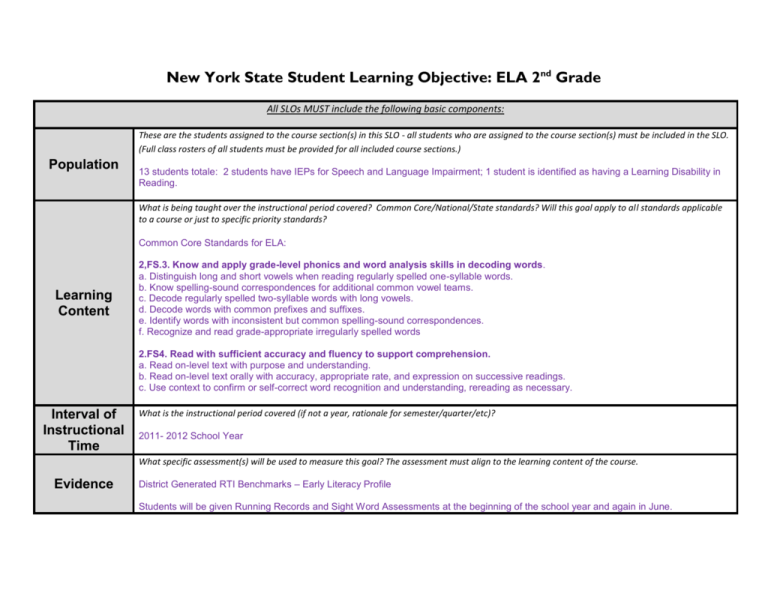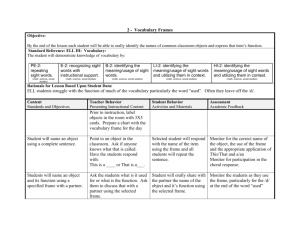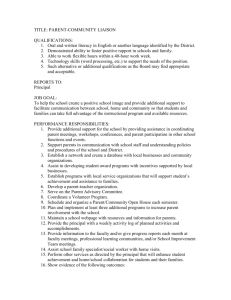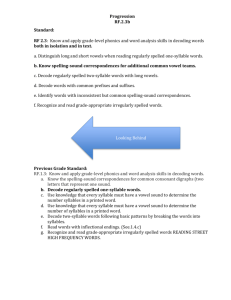New York State Student Learning Objective Template
advertisement

New York State Student Learning Objective: ELA 2nd Grade All SLOs MUST include the following basic components: These are the students assigned to the course section(s) in this SLO - all students who are assigned to the course section(s) must be included in the SLO. (Full class rosters of all students must be provided for all included course sections.) Population 13 students totale: 2 students have IEPs for Speech and Language Impairment; 1 student is identified as having a Learning Disability in Reading. What is being taught over the instructional period covered? Common Core/National/State standards? Will this goal apply to all standards applicable to a course or just to specific priority standards? Common Core Standards for ELA: Learning Content 2,FS.3. Know and apply grade-level phonics and word analysis skills in decoding words. a. Distinguish long and short vowels when reading regularly spelled one-syllable words. b. Know spelling-sound correspondences for additional common vowel teams. c. Decode regularly spelled two-syllable words with long vowels. d. Decode words with common prefixes and suffixes. e. Identify words with inconsistent but common spelling-sound correspondences. f. Recognize and read grade-appropriate irregularly spelled words 2.FS4. Read with sufficient accuracy and fluency to support comprehension. a. Read on-level text with purpose and understanding. b. Read on-level text orally with accuracy, appropriate rate, and expression on successive readings. c. Use context to confirm or self-correct word recognition and understanding, rereading as necessary. Interval of Instructional Time What is the instructional period covered (if not a year, rationale for semester/quarter/etc)? 2011- 2012 School Year What specific assessment(s) will be used to measure this goal? The assessment must align to the learning content of the course. Evidence District Generated RTI Benchmarks – Early Literacy Profile Students will be given Running Records and Sight Word Assessments at the beginning of the school year and again in June. What is the starting level of students’ knowledge of the learning content at the beginning of the instructional period? Running Record Reading Level: These are instructional levels. Students must score 90% - 94% to be instructional; 95% or better for an independent level. Students are expected to be at an Instructional Level of I at the beginning of Grade 2 and an Instructional Level N at the end of Grade 2. Level F – Students 8, 11 (Below level) Level G - Students 1,4,5, 6, 10, 12, 13 (Below Level ) Level H – Students 2,7 (Below level) Level I – Student 3 (On level) Level K – Student 9 (On level) Baseline Sight Word Benchmarks: Students who were At Risk with sight word benchmarks (At Risk is defined as below 85% of First Grade Sight Words (144/170): Students 1 (143/170) 84% 9 (139/170) 82% 3(143/170) 84% 12 (121/170) 71% 6 (143/170) 84% 13 (130/170) 76% 8(129/170) 76% Students who were Not at Risk with sight word benchmarks (Not at risk is defined as 85% or higher of First Grade Sight Words): Students 2 (148/170) 87% 7 (156/170) 92% 4 (155/170) 91% 10 (168/170) 99% 5 (155/170) 91% 11 (160/170) 94% What is the expected outcome (target) of students’ level of knowledge of the learning content at the end of the instructional period? Target(s) 2nd Grade Students will have successfully progressed through 4 reading levels. (Accuracy scores and comprehension scores will be averaged for the levels attained.) A student must score 95% to be considered an independent reader at any given level. 85% of 2nd Grade Students will have achieved determined benchmarks for Second Grade sight word. (288 out of 320 words, 90%) HEDI Scoring How will evaluators determine what range of student performance “meets” the goal (effective) versus “well-below” (ineffective), “below” (developing), and “well-above” (highly effective)? The score the teacher receives is the average of the two strand scores identified below. (For example, if a teacher scores a 14 on reading levels and a 12 on sight words; the score is the average of the two, 13.) HIGHLY EFFECTIVE Class average of the number of Reading Levels successfully advanced. %age of students achieving proficiency with Grade 2 sight words Rationale EFFECTIVE DEVELOPING INEFFECTIVE 20 19 18 17 16 15 14 13 12 11 10 9 8 7 6 5 4 3 2 1 0 5.4 and mor e 5.2 5.0 4.8 4.6 4.4 4.2 4.0 3.8 3.6 3.4 3.2 3.0 2.8 2.6 2.4 2.2 2.0 1.8 1.6 1.4 and less 50 % 100 And less Describe the reasoning behind the choices regarding learning content, evidence, and target and how they will be used together to prepare students for future growth and development in subsequent grades/courses, as well as college and career readiness. 99 % 98 % 9697 % 9395 % 9092 % 8789 % 8486 % 8182 % 7880 % 7577 % 7274 % 7071 % 6869 % 6567 % 6264 % 6062 % 5859 % 5657 % 5155 % Students must be able to decode and recognize words before they can develop the comprehension skills necessary to read a variety of genre. These foundational skills measure a student’s ability to read fluently and accurately. They also assess comprehension. The target was chosen based on data from the past three years. Information on the performance of students on these assessments can be used to provide diversified instruction based on individual needs. The results of the assessments will inform the teacher on areas which need further instruction.









